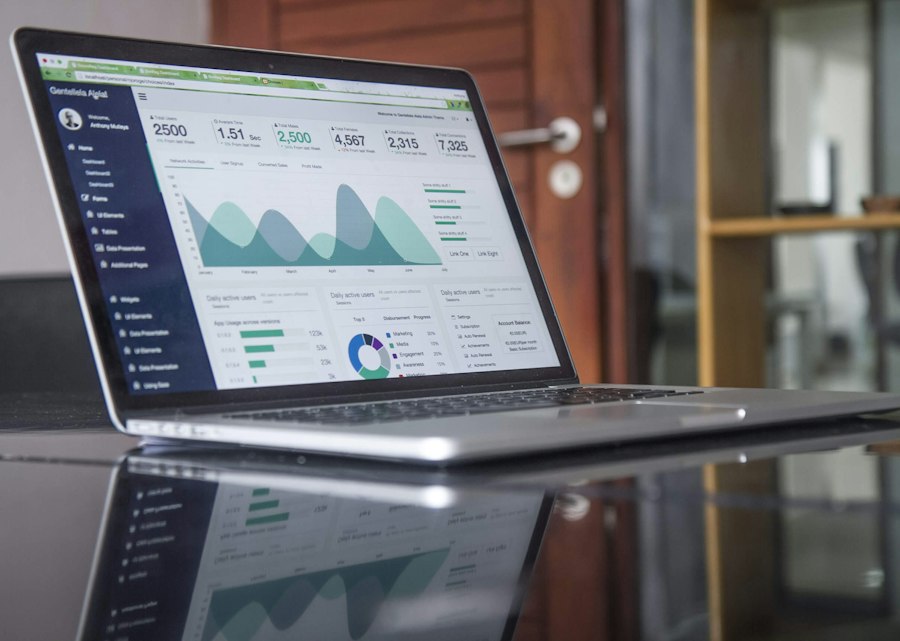Data visualization is the graphical representation of data and information. It allows businesses to understand complex data sets and patterns more easily, making it an essential tool for decision-making. Google Analytics dashboards are a powerful tool that allows businesses to visualize and analyze their website data. These dashboards provide a comprehensive view of key metrics and performance indicators, helping businesses make informed decisions.
Google Analytics dashboards are customizable and can be tailored to specific business goals and objectives. They provide real-time data on website traffic, user behavior, conversions, and more. With the ability to add and remove widgets, rearrange them for better visibility, and apply filters and segments, businesses can create impactful dashboards that provide valuable insights.
Key Takeaways
- Data visualization and Google Analytics dashboards are important tools for businesses to gain insights and make informed decisions.
- Impactful insights are crucial for businesses to stay competitive and achieve their goals.
- Choosing the right metrics for your Google Analytics dashboard is essential to track progress and measure success.
- Customizing your Google Analytics dashboard can help you focus on the most important data and make it more visually appealing.
- Using filters and segments in Google Analytics can help you analyze data more effectively and create more targeted visualizations.
Understanding the Importance of Impactful Insights in Business
Data plays a crucial role in decision-making for businesses. It provides insights into customer behavior, market trends, and overall performance. Impactful insights derived from data analysis can help businesses identify opportunities for growth, optimize marketing strategies, improve customer experience, and make informed decisions.
The benefits of impactful insights are numerous. They enable businesses to identify areas of improvement, optimize marketing campaigns for better ROI, understand customer preferences and behavior, and make data-driven decisions. By leveraging data visualization tools like Google Analytics dashboards, businesses can gain a deeper understanding of their data and extract meaningful insights that drive growth.
Choosing the Right Metrics for Your Google Analytics Dashboard
When creating a Google Analytics dashboard, it is important to identify key performance indicators (KPIs) that align with your business goals. KPIs are specific metrics that measure the success of your objectives. For example, if your goal is to increase website conversions, relevant KPIs would include conversion rate, average order value, and revenue generated.
Selecting relevant metrics for your business goals is crucial for creating an impactful dashboard. It is important to focus on metrics that provide actionable insights and help you track progress towards your objectives. By choosing the right metrics, you can ensure that your dashboard provides meaningful information that drives decision-making.
Customizing Your Google Analytics Dashboard for Maximum Impact
Customizing your Google Analytics dashboard is essential for maximum impact. By adding and removing widgets, you can focus on the metrics that are most relevant to your business goals. For example, if you are primarily interested in tracking website traffic and user behavior, you can add widgets that display metrics such as sessions, bounce rate, and average session duration.
Rearranging widgets for better visibility is another important customization feature of Google Analytics dashboards. By organizing widgets in a logical and intuitive manner, you can ensure that the most important metrics are easily accessible and understandable. This can help stakeholders quickly grasp the key insights from the dashboard.
Using Google Analytics Filters and Segments to Enhance Your Dashboard
Google Analytics filters and segments are powerful tools that can enhance your dashboard by providing more focused and relevant data. Filters allow you to exclude or include specific data based on predefined criteria. For example, you can filter out internal traffic from your dashboard to get a more accurate view of user behavior.
Segments, on the other hand, allow you to divide your data into subsets based on specific criteria. This can help you gain deeper insights into different user groups or segments. For example, you can create a segment for users who have made a purchase on your website and analyze their behavior separately from non-purchasing users.
Creating Interactive Data Visualizations with Google Analytics

Google Analytics provides a range of data visualization tools that allow businesses to create interactive and engaging visualizations. These tools include charts, graphs, maps, and more. By leveraging these tools, businesses can present their data in a visually appealing and easy-to-understand format.
When creating data visualizations with Google Analytics, it is important to keep a few tips in mind. First, choose the right type of visualization for your data. Different types of data require different types of visualizations. For example, if you want to compare data over time, a line chart would be more appropriate than a pie chart.
Second, keep your visualizations simple and uncluttered. Avoid using too many colors or unnecessary elements that can distract from the main message. Use clear labels and titles to ensure that the information is easily understandable. Finally, make your visualizations interactive by adding tooltips or drill-down capabilities. This allows users to explore the data in more detail and gain deeper insights.
Incorporating External Data Sources into Your Google Analytics Dashboard
In addition to website data, businesses can also incorporate external data sources into their Google Analytics dashboard for a more comprehensive view. This can include data from CRM systems, social media platforms, email marketing tools, and more. By combining data from different sources, businesses can gain a more holistic understanding of their performance and make more informed decisions.
To incorporate external data sources into your Google Analytics dashboard, you can use data import tools or third-party integrations. Data import tools allow you to upload data from external sources directly into Google Analytics. Third-party integrations, on the other hand, enable you to connect your Google Analytics account with other platforms and automatically import data.
Best Practices for Sharing and Presenting Your Google Analytics Dashboard
Sharing and presenting your Google Analytics dashboard effectively is crucial for ensuring that the insights are understood and acted upon. When sharing your dashboard, it is important to choose the right format for your audience. Consider whether a static PDF report or an interactive online dashboard would be more appropriate.
When presenting your dashboard, highlight key insights and actionable recommendations. Avoid overwhelming your audience with too much information and focus on the metrics that are most relevant to their interests or objectives. Use clear visuals and concise explanations to ensure that the insights are easily understandable.
Common Mistakes to Avoid When Creating Google Analytics Dashboards
When creating Google Analytics dashboards, there are some common mistakes that businesses should avoid. One common mistake is overcomplicating the dashboard by including too many metrics or unnecessary elements. This can make the dashboard confusing and difficult to understand. Instead, focus on the metrics that are most relevant to your business goals and objectives.
Another common mistake is focusing on vanity metrics, which are metrics that may look impressive but do not provide meaningful insights. For example, total website traffic or social media followers may be impressive numbers, but they do not necessarily indicate the success of your business. Instead, focus on metrics that directly impact your objectives, such as conversion rate or revenue generated.
Advanced Techniques for Mastering Google Analytics Dashboards and Data Visualization
For businesses looking to take their Google Analytics dashboards and data visualization to the next level, there are advanced techniques that can be employed. One such technique is using custom dimensions and metrics. Custom dimensions allow businesses to track additional data points that are not available by default in Google Analytics. This can provide more granular insights into user behavior and preferences.
Creating custom reports for specific needs is another advanced technique that can be used to master Google Analytics dashboards. Custom reports allow businesses to create tailored reports that focus on specific metrics or segments. This can be useful for analyzing specific campaigns, user groups, or performance indicators.
In conclusion, data visualization and Google Analytics dashboards are powerful tools that can provide impactful insights for businesses. By choosing the right metrics, customizing the dashboard, incorporating external data sources, and using advanced techniques, businesses can create dashboards that provide valuable insights and drive decision-making. With the right approach and best practices in place, businesses can leverage data visualization to gain a competitive edge and achieve their objectives.
If you’re looking to take your data visualization skills to the next level, you won’t want to miss this insightful article on mastering Google Analytics dashboards for impactful insights. In this article, you’ll discover how to leverage the power of Google Analytics to create visually stunning and highly informative dashboards that will help you make data-driven decisions with confidence. Whether you’re a beginner or an experienced user, this article from Martech.com.my is a must-read for anyone looking to unlock the full potential of Google Analytics. Check it out here!
FAQs
What is data visualization?
Data visualization is the representation of data in a graphical or pictorial format that helps people understand complex data sets more easily.
What is Google Analytics?
Google Analytics is a free web analytics service offered by Google that tracks and reports website traffic.
What are Google Analytics dashboards?
Google Analytics dashboards are customizable collections of widgets that display key metrics and data visualizations for a website or app.
Why is data visualization important?
Data visualization is important because it helps people understand complex data sets more easily and quickly. It can also help identify patterns and trends that might not be apparent in raw data.
What are some best practices for creating effective data visualizations?
Some best practices for creating effective data visualizations include choosing the right type of chart or graph for the data, using clear and concise labels and titles, and avoiding clutter and unnecessary elements.
How can Google Analytics dashboards be used to gain insights?
Google Analytics dashboards can be used to gain insights by displaying key metrics and data visualizations that help identify patterns and trends in website or app traffic. This information can be used to make data-driven decisions and improve website or app performance.

